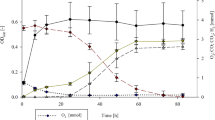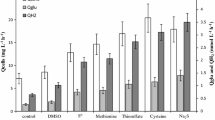Abstract
Virtually all members of the order Thermotogales have demonstrated the ability to produce hydrogen; however, some members of this order produce considerably greater quantities than others. With one representative of this order, Thermotoga neapolitana, we have consistently obtained accumulation of 25–30% hydrogen with 12–15% carbon dioxide as the only other prominent product in the batch reaction. In contradistinction to information widely disseminated in the literature, we have also found that most members of this order tolerate and appear to utilize the moderate amounts of oxygen present in the gaseous phase of batch reactors (6–12%), with no apparent decrease in hydrogen production. Hydrogen accumulation has been widely reported to inhibit growth of Thermotogales. While this may be true at very high hydrogen tensions, we have observed log phase bacterial morphology (rods) even in the presence of 25–35% hydrogen concentrations. To maximize hydrogen production and minimize production of hydrogen sulfide, inorganic sulfur donors are avoided and the cysteine concentration in the medium is increased. We and others have demonstrated that different members of the order Thermotogales utilize a wide variety of feedstocks, including complex carbohydrates and proteins. Thus, it appears that organisms within this order have the potential to utilize a variety of organic wastes and to cost-effectively generate hydrogen.
Similar content being viewed by others
References
Heydorn, B., Schwendener, H., and Mori, S. (1998), Hydrogen Product Review Chemical Economics Handbook.
Padro, C. E. G. and Putche, V. (1999), NREL/TP-570-27079, Survey of the Economics of Hydrogen Technologies.
US department of Energy (1998), DOE/GO-10098-532, DOE Hydrogen Program Strategic Plan-Twenty-Year Vision.
US Department of Energy (1995), DOE/GO 10095-088, Hydrogen Program Overview Produced by the National Renewable Energy Laboratory for the DOE.
(1999), in BioHydrogen, Zaborsky, O. R., ed., Plenum, NY.
Kaplan, S. and Moore, M. D. (1998), US patent no. 5,804,424.
Vatsala, T. M. (1990), US patent no. 4,921,800.
Weaver, P. F. (1990), US patent no. 4,919,813.
Melis, A. L., Zhang, M., Foredtier, M., Ghirardi, M. L., and Seibert, M. (2000), Plant Physiol. 122, 127–136 (2000).
Huber, R., Langworthy, T. A., Konig, H., et al. (1986), Arch. Microbiol. 144, 324–333.
Belkin, B., Wirsen, C. O., and Jannasch, H. W. (1986) Appl. Env. Microbiol. 51(6), 1180–1185.
Jannasch, H. W., Huber, R., Belkin, S., and Stetter, K. O. (1988), Arch. Microbiol. 150, 103–104.
Huber, R. and Stetter, K. O. (1992). in The Prokaryotes, 2nd ed., Balows, A., Truper, H. G., Dworkin, M., et al., eds., Springer-Verlag, NY, pp. 3809–3815.
Adams, M. W. W. (1994), FEMS Microbiol. Rev. 15, 261–277.
Childers, S. E., Vargas, M., and Noll, K. M. (1992), Appl. Environ. Microbiol. 58, 3949–3953.
Thauer, R. K., Jungerman, K., and Decker, K. (1977) Bacteriol. Rev. 41, 100–180.
Kelly, R. M. and Adams, M. W. W. (1994) Antonie van Leeuwenhoek 66, 247–270.
Shiba, H., Kawasumi, T., Igarashi, Y., Kodama, T., and Minoda, Y. (1985) Arch. Microbiol. 141, 198–203.
Beh, M., Strauss, G., Huber, R., Stetter, K. O., Fuchs, G. (1993) Archives of Microbiology 160(4), 306–311.
Author information
Authors and Affiliations
Corresponding author
Rights and permissions
About this article
Cite this article
Van Ooteghem, S.A., Beer, S.K. & Yue, P.C. Hydrogen production by the thermophilic bacterium Thermotoga neapolitana . Appl Biochem Biotechnol 98, 177–189 (2002). https://doi.org/10.1385/ABAB:98-100:1-9:177
Issue Date:
DOI: https://doi.org/10.1385/ABAB:98-100:1-9:177




